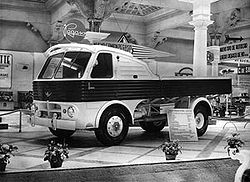
Pegaso Z-207
Encyclopedia

Pegaso
Pegaso was a Spanish make of trucks, omnibuses, tractors, armored vehicles, and, for a while, sports cars. The parent company, Enasa, was created in 1946 and based in the old Hispano-Suiza factory, under the direction of the renowned automotive engineer Wifredo Ricart...
Z-207 was a truck model produced in Spain by Enasa
Enasa
ENASA was a Spanish vehicle manufacturing company, incorporated in 1946 having bought the automotive assets of the Spanish arm of Hispano-Suiza. It produced trucks, buses and military armored vehicles under the Pegaso and, for a short while, Sava brands. Enasa belonged to the state-owned INI...
from 1955 to 1959. It featured a splendid V6 engine
V6 engine
A V6 engine is a V engine with six cylinders mounted on the crankcase in two banks of three cylinders, usually set at either a right angle or an acute angle to each other, with all six pistons driving a common crankshaft...
and a stylishly unforgettable cab. It was nicknamed Barajas
Barajas (district)
Barajas is the name of a district belonging to the city of Madrid, Spain.-Subdivision:The district is administratively divided into 5 wards :*Aeropuerto*Alameda de Osuna *Casco Histórico de Barajas...
, for the location, close to Madrid
Madrid
Madrid is the capital and largest city of Spain. The population of the city is roughly 3.3 million and the entire population of the Madrid metropolitan area is calculated to be 6.271 million. It is the third largest city in the European Union, after London and Berlin, and its metropolitan...
, where a new Pegaso plant was built to produce the Z-207.
The Z-207 was an astonishing truck, very advanced for its time, specially due to the system of direct injection and the use of light aluminum alloy from which the whole engine block was built. Also outstanding was its high performance and perfect balance at all speeds, thanks to the balance shaft with counterrotating masses under the crankshaft. The engine had two interchangeable cylinder heads, one for each group of three cylinders, and cylinder liners of a special cast-iron. It was a 7. 5 lts 120º V6 machine, delivering initially 110 and later 120 horsepower
Horsepower
Horsepower is the name of several units of measurement of power. The most common definitions equal between 735.5 and 750 watts.Horsepower was originally defined to compare the output of steam engines with the power of draft horses in continuous operation. The unit was widely adopted to measure the...
, enough for the vehicle to reach a top speed of 90 km/h, with its maximum weight of 11,320 kg
Another of the fundamental characteristics of the Z-207 was the independent front suspension with two superimposed trapezoids with helicoidal springs, each with a corresponding shock absorber offering a degree of comfort hitherto never attained in an industrial vehicle. A big spring joined both wheels, so guaranteeing great strength even in full load.
A further outstanding feature was the three-speed gearbox divided by the splitter-type system into three low and three high, combined with a two-speed rear axle producing a total of twelve speeds. The splitter control was mechanical, by means of a lever situated under the steering column.
The "Barajas" range also included the Z-702, an articulated truck
Semi-trailer truck
A semi-trailer truck, also known as a semi, tractor-trailer, or articulated truck or articulated lorry, is an articulated vehicle consisting of a towing engine , and a semi-trailer A semi-trailer truck, also known as a semi, tractor-trailer, or (in the United Kingdom and Ireland) articulated truck...
tractor for semi-trailers suitable for a payload of ten tons, and the Z-407, a rear-engined coach that never went into mass production. There was also a four-wheel-drive prototype, coded Z-213.
Unfortunately the Z-207 was expensive to build and to maintain and was gradually replaced by the much more conventional but better-selling Pegaso Comet, which included some Leyland components. Total production of the Z-207 range was 5,737 units.

